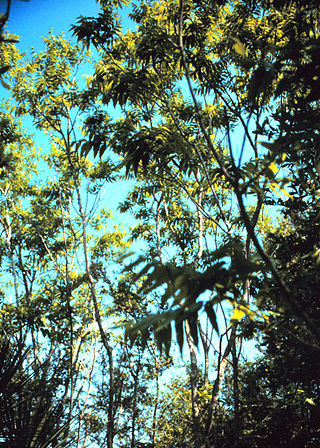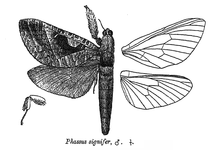
Albizia is a genus of more than 160 species of mostly fast-growing subtropical and tropical trees and shrubs in the subfamily Mimosoideae of the family Fabaceae. The genus is pantropical, occurring in Asia, Africa, Madagascar, America and Australia, but mostly in the Old World tropics. In some locations, some species are considered weeds.

The Hepialidae are a family of insects in the lepidopteran order. Moths of this family are often referred to as swift moths or ghost moths.

Theobroma is a genus of flowering plants in the mallow family, Malvaceae, that is sometimes classified as a member of Sterculiaceae. It contains roughly 20 species of small understory trees native to the tropical forests of Central and South America.

Sapindus is a genus of about five to twelve species of shrubs and small trees in the lychee family, Sapindaceae, native to warm temperate to tropical regions of the world. The genus includes both deciduous and evergreen species. Members of the genus are commonly known as soapberries or soapnuts because the fruit pulp is used to make soap. The generic name is derived from the Latin words sapo, meaning "soap", and indicus, meaning "of India".

Endoclita is a genus of moths of the family Hepialidae. There are 60 described species found in eastern and southeast Asia and the Indian subcontinent.
Endoclita absurdus is a species of moth of the family Hepialidae. It is known from China.
Endoclita auratus is a species of moth of the family Hepialidae. It is known from Myanmar. The food plants for this species are Alnus, Cryptomeria, and Eucalyptus.
Endoclita broma is a species of moth of the family Hepialidae. It is known from Java, Indonesia.

Endoclita damor is a species of moth of the family Hepialidae. It is known from India and the Himalayas. Food plants for this species include Albizia, Altingia, Cinchona, Coffea, Erythrina, Eugenia, Glochidion, Manglietia, Nyssa, Schima, Tectona, Tetradium, and Theobroma.
Endoclita excrescens is a species of moth of the family Hepialidae. It is known from Japan and the Russian Far East. Food plants for this species include Castanea, Nicotiana, Paulownia, Quercus, and Raphanus. The species is considered a pest of the tobacco plant.
Endoclita hoesi is a species of moth of the family Hepialidae. It is known from Borneo. Food plants for this species include Elettaria, Eucalyptus, and Theobroma.
Endoclita jingdongensis is a species of moth of the family Hepialidae. It is known from Yunnan, China.
Endoclita magnus is a species of moth of the family Hepialidae. It is known from India.

Endoclita malabaricus is a species of moth of the family Hepialidae. It is known from India.
Endoclita punctimargo is a species of moth of the family Hepialidae first described by Charles Swinhoe in 1892. It is known from the Indian state of Sikkim.
Endoclita sericeus is a species of moth of the family Hepialidae first described by Charles Swinhoe in 1901. It is known from Java, Indonesia. Food plants for this species include Albizia, Camellia, Cinchona, Crotalaria, Manihot, Tectona, and Theobroma.
Endoclita sibelae is a species of moth of the family Hepialidae. It is known from the Moluccas (Bacan).

Endoclita sinensis is a species of moth of the family Hepialidae. It is known from China, Korea and Taiwan, as well as from the Far East of Russia. Food plants for this species include Castanea and Quercus.
Endoclita viridis is a species of moth of the family Hepialidae first described by Charles Swinhoe in 1892. It is known from India.
Endoclita makundae is a species of ghost moth (Hepialidae) described from Assam, India.








